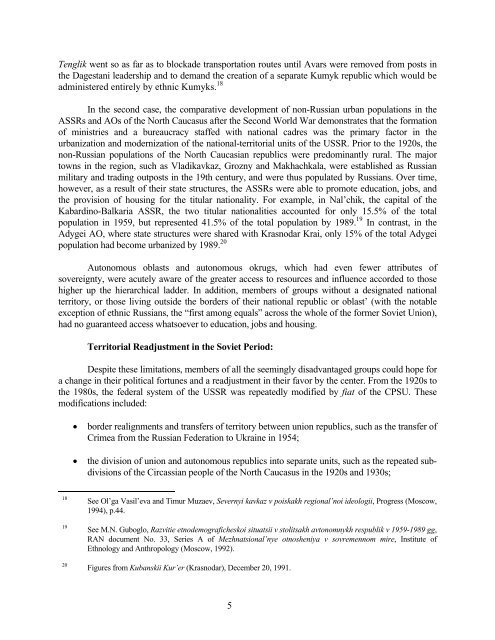RUSSIA'S TINDERBOX - Belfer Center for Science and International ...
RUSSIA'S TINDERBOX - Belfer Center for Science and International ...
RUSSIA'S TINDERBOX - Belfer Center for Science and International ...
You also want an ePaper? Increase the reach of your titles
YUMPU automatically turns print PDFs into web optimized ePapers that Google loves.
Tenglik went so as far as to blockade transportation routes until Avars were removed from posts in<br />
the Dagestani leadership <strong>and</strong> to dem<strong>and</strong> the creation of a separate Kumyk republic which would be<br />
administered entirely by ethnic Kumyks. 18<br />
In the second case, the comparative development of non-Russian urban populations in the<br />
ASSRs <strong>and</strong> AOs of the North Caucasus after the Second World War demonstrates that the <strong>for</strong>mation<br />
of ministries <strong>and</strong> a bureaucracy staffed with national cadres was the primary factor in the<br />
urbanization <strong>and</strong> modernization of the national-territorial units of the USSR. Prior to the 1920s, the<br />
non-Russian populations of the North Caucasian republics were predominantly rural. The major<br />
towns in the region, such as Vladikavkaz, Grozny <strong>and</strong> Makhachkala, were established as Russian<br />
military <strong>and</strong> trading outposts in the 19th century, <strong>and</strong> were thus populated by Russians. Over time,<br />
however, as a result of their state structures, the ASSRs were able to promote education, jobs, <strong>and</strong><br />
the provision of housing <strong>for</strong> the titular nationality. For example, in Nal’chik, the capital of the<br />
Kabardino-Balkaria ASSR, the two titular nationalities accounted <strong>for</strong> only 15.5% of the total<br />
population in 1959, but represented 41.5% of the total population by 1989. 19 In contrast, in the<br />
Adygei AO, where state structures were shared with Krasnodar Krai, only 15% of the total Adygei<br />
population had become urbanized by 1989. 20<br />
Autonomous oblasts <strong>and</strong> autonomous okrugs, which had even fewer attributes of<br />
sovereignty, were acutely aware of the greater access to resources <strong>and</strong> influence accorded to those<br />
higher up the hierarchical ladder. In addition, members of groups without a designated national<br />
territory, or those living outside the borders of their national republic or oblast’ (with the notable<br />
exception of ethnic Russians, the “first among equals” across the whole of the <strong>for</strong>mer Soviet Union),<br />
had no guaranteed access whatsoever to education, jobs <strong>and</strong> housing.<br />
Territorial Readjustment in the Soviet Period:<br />
Despite these limitations, members of all the seemingly disadvantaged groups could hope <strong>for</strong><br />
a change in their political <strong>for</strong>tunes <strong>and</strong> a readjustment in their favor by the center. From the 1920s to<br />
the 1980s, the federal system of the USSR was repeatedly modified by fiat of the CPSU. These<br />
modifications included:<br />
• border realignments <strong>and</strong> transfers of territory between union republics, such as the transfer of<br />
Crimea from the Russian Federation to Ukraine in 1954;<br />
• the division of union <strong>and</strong> autonomous republics into separate units, such as the repeated subdivisions<br />
of the Circassian people of the North Caucasus in the 1920s <strong>and</strong> 1930s;<br />
18 See Ol’ga Vasil’eva <strong>and</strong> Timur Muzaev, Severnyi kavkaz v poiskakh regional’noi ideologii, Progress (Moscow,<br />
1994), p.44.<br />
19 See M.N. Guboglo, Razvitie etnodemograficheskoi situatsii v stolitsakh avtonomnykh respublik v 1959-1989 gg,<br />
RAN document No. 33, Series A of Mezhnatsional’nye otnosheniya v sovremennom mire, Institute of<br />
Ethnology <strong>and</strong> Anthropology (Moscow, 1992).<br />
20 Figures from Kubanskii Kur’er (Krasnodar), December 20, 1991.<br />
5
















